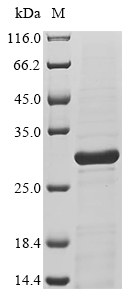The construction of a plasmid coding for the Macaca fascicularis (Crab-eating macaque) IL11 protein (22-199aa) is the initial step for the preparation of the recombiant Macaca fascicularis (Crab-eating macaque) IL11 protein. The next is to transform the constructed plasmid into e.coli cells. e.coli cells containing the plasmid are screened and then cultured under conditions that promote the expression of the gene of interest. The protein is equipped with a N-terminal 6xHis tag. After that, affinity purification is used to isolate and purify the recombinant IL11 protein from the cell lysate. Finally, the resulting recombinant IL11 protein undergoes SDS-PAGE analysis, demonstrating a purity greater than 85%.






